
| The 1900s | ||||||||||||||||||
1900s |
Animal acts |
 Audiences began to anthropomorphize animals, and to want them to be treated well. They were less likely to identify with trainers.
Audiences began to anthropomorphize animals, and to want them to be treated well. They were less likely to identify with trainers.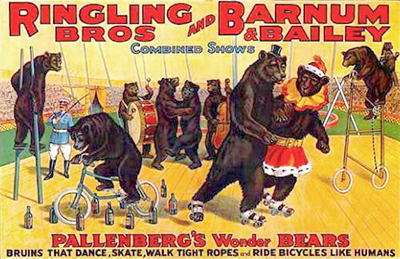 For the first half of the century, chimps were dressed and performed like people, while kangaroos boxed men. Dogs (especially Jack Russell terriers) did human tricks, often with acrobats or clowns. For the first half of the century, chimps were dressed and performed like people, while kangaroos boxed men. Dogs (especially Jack Russell terriers) did human tricks, often with acrobats or clowns.Bears were generally clowns.
Large circuses were often successful animal breeders: their animals were generations away from the wild. Lucia Zora, "the bravest woman in the world," worked extensively with elephants. She used positive training only, based on observation and repetition.
|
||||||||||||||||
New inventions are incorporated |
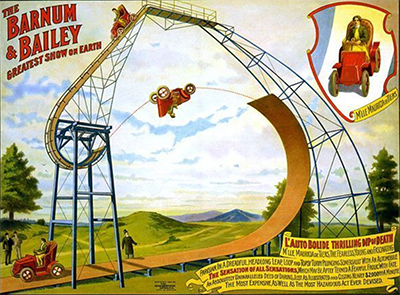 Mademoiselle de Tiers drove a loop-the-loop track in her "meteor car."
Mademoiselle de Tiers drove a loop-the-loop track in her "meteor car." Novelties like swallowing glowing neon tubes came into sideshows. |
|||||||||||||||||
Acts get more extreme |
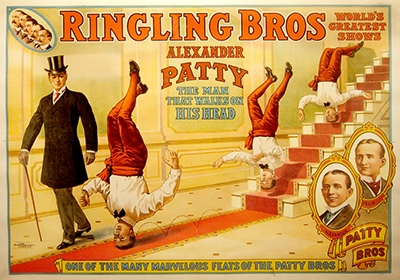
.jpg) Alexander Patty bounced down stairs on his head using no hands. Alexander Patty bounced down stairs on his head using no hands.Hilary Long skated on his head—and jumped a gap. Finger balancers did a handstand, but on one finger.
|
|||||||||||||||||
First black circus star |
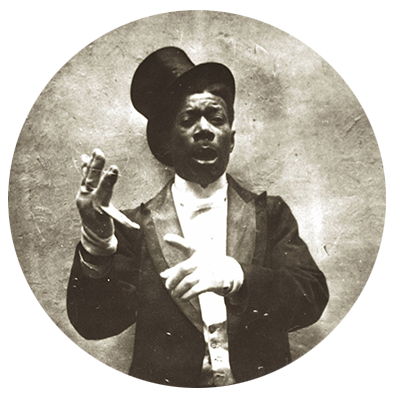
At the turn of the century the clown Chocolat took Paris by storm. Chocolat, née Rafael, was from Cuba. He was discovered while working the docks in Bilbao. |
|||||||||||||||||
|
|
||||||||||||||||||
1900 |
Quintessential circus romance story in France's Nouveau Cirque |
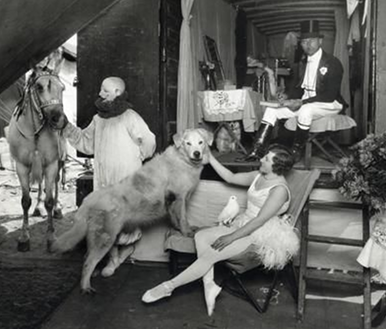 Someone threw flowers to Ella Bradna, pretty equestrienne daughter of a circus family, as she stood en pointe on her horse. The startled horse reared, throwing Ella into the arms of cavalry lieutenant Frederick Ferbere. Two months later they were married. Ferbere, heir to a German brewing fortune, took her name and gave up the family business to become a renowned circus ringmaster. Someone threw flowers to Ella Bradna, pretty equestrienne daughter of a circus family, as she stood en pointe on her horse. The startled horse reared, throwing Ella into the arms of cavalry lieutenant Frederick Ferbere. Two months later they were married. Ferbere, heir to a German brewing fortune, took her name and gave up the family business to become a renowned circus ringmaster. |
||||||||||||||||
1902 |
Animal crackers |
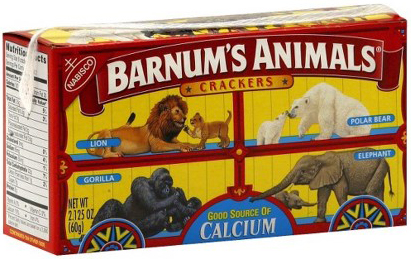 Nabisco introduced Barnum's Animal Crackers, with a string on the box so that it could be hung on a Christmas tree. Nabisco introduced Barnum's Animal Crackers, with a string on the box so that it could be hung on a Christmas tree.
|
||||||||||||||||
1903 |
Barnum sideshow artists protest |
They protested the label "freak" but seemed to be fine with being stared at in the 10-in-1. They preferred to be referred to as "prodigies." |
||||||||||||||||
c. 1903 |
Ouch |
My paternal grandfather Pop saw a circus and was inspired to try to do a back flip. He allowed years later that it was a mistake to do this in the cinder alley. |
||||||||||||||||
1904 |
Women in the Olympics |
Six women competed. |
||||||||||||||||
1905 |
Ringling Brothers buys a large circus |
|||||||||||||||||
1905 |
Strong Sandwinas |
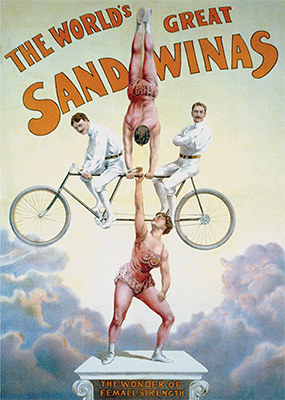
Katie Sandwina, born to a circus family in 1884, lifted three men on a bicycle. She and her strong husband Max Heymann performed as the Sandwinas. |
||||||||||||||||
1906 |
Shrine Circus founded |
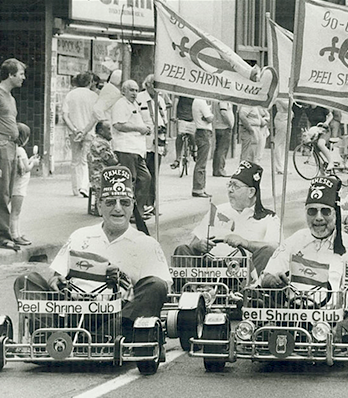 The first Shrine Circus, one ring, was in Detroit. The circus was affiliated with the Ancient Arabic Order of the Nobles of the Mystic Shrine (now Shriners International). The first Shrine Circus, one ring, was in Detroit. The circus was affiliated with the Ancient Arabic Order of the Nobles of the Mystic Shrine (now Shriners International).
|
||||||||||||||||
1906 |
Bailey dies |
|||||||||||||||||
1907 |
Ringling buys Barnum and Bailey |
Ringling Brothers purchased the Barnum & Bailey Circus, but ran it separately initially. |
||||||||||||||||
1907 |
Human Prodigies Society |
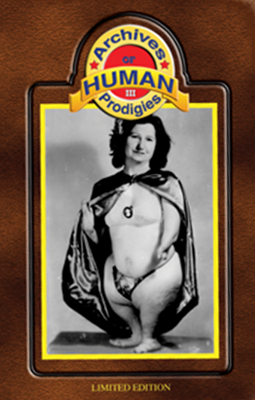 Sideshow artists formed a union-like social society exclusive to "human curiosities." They held dances and worked for retirement and for support for ill members. Sideshow artists formed a union-like social society exclusive to "human curiosities." They held dances and worked for retirement and for support for ill members. |
||||||||||||||||
1907 |
Sacred tattooed bull |
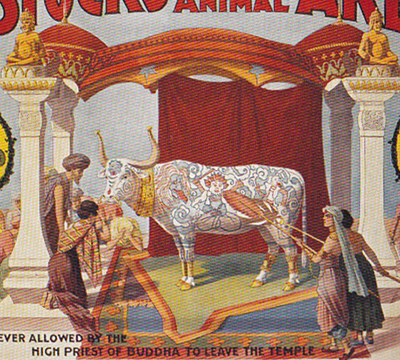 Faked by Frank C. Bostock. Faked by Frank C. Bostock. |
||||||||||||||||
1907 |
Animals escape from train wreck in Virginia |
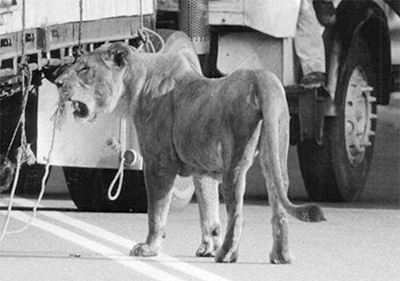 Animal escapes were rare, but they were exciting and great publicity. Animal escapes were rare, but they were exciting and great publicity. |
||||||||||||||||
1908 |
Ringling drops its sideshows for five years |
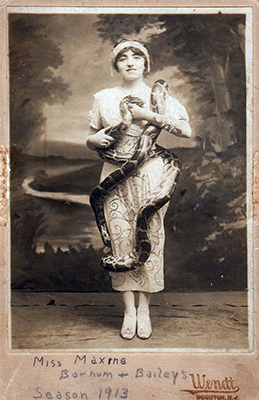 The closure was in response to pressure to show ever freakier exhibits. The prodigies were left in the lurch when the sideshow closed (but there were places like Coney Island for some of them).
The sideshow was reinstituted in 1913. The closure was in response to pressure to show ever freakier exhibits. The prodigies were left in the lurch when the sideshow closed (but there were places like Coney Island for some of them).
The sideshow was reinstituted in 1913. |
||||||||||||||||
1909 |
Edward Wulff and 120 horses |
Wulff's Great Continental Circus came to America with his huge liberty act. |
||||||||||||||||
1910s |
Zelda Boden |
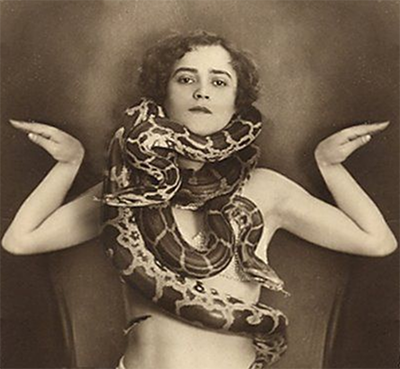 This celebrity vamp preceded movie star Theda Bara. This celebrity vamp preceded movie star Theda Bara.
|
||||||||||||||||
Ringling Brothers spectacles |
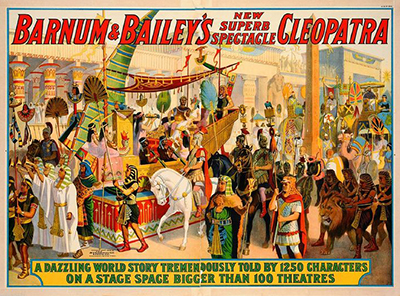
Ben Hur was featured in 1912. Biblical stories were popular. See, circuses are educational! |
|||||||||||||||||
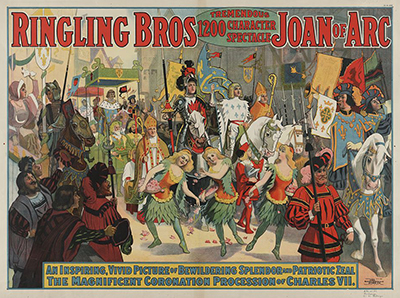
1913 brought Joan of Arc. It was advertised as including 1,200 characters, 300 dancing girls (who maybe changed costumes four times to make 1,200 characters). |
||||||||||||||||||
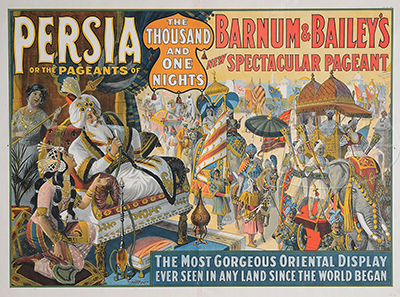
In 1916 it was Arabian Nights: Persian, Indian, and Arabian stories allowed animals to have roles. |
||||||||||||||||||
1914–1918 |
World War I |
America joined in 1917. |
||||||||||||||||
1914 |
Chinese(?) troupes featured |
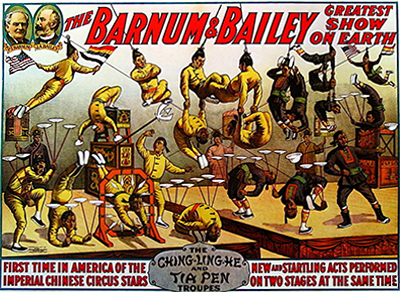
Ching-Ling-He and Tai Pen troupes (called Chinese but maybe Japanese) showed off distinctive styles of acrobatics, juggling, and bending. |
||||||||||||||||
1917 |
First celebrity based on beauty contest |
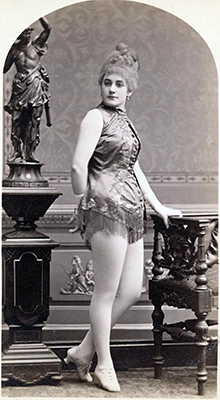 Adam Forepaugh held a nationwide beauty contest to find Louise Manague to lead his spec. Adam Forepaugh held a nationwide beauty contest to find Louise Manague to lead his spec. |
||||||||||||||||
1918 |
The Ringling Brothers and Barnum & Bailey in one show! |
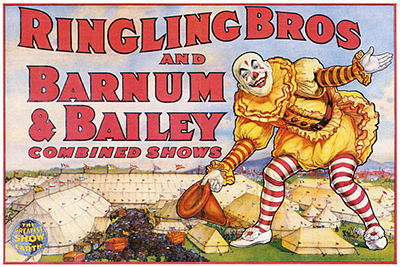 It was now indisputably The Greatest on Earth. And it grew like Topsy. It was now indisputably The Greatest on Earth. And it grew like Topsy. Clown Emmett Kelly said that being in the "Big One" is the highest point in a performer's career.
Of the five Ringling brothers, only Charles and John were left. Charles ran the show until he died in 1926. |
||||||||||||||||
1918 |
Mabel Stark, animal training star |
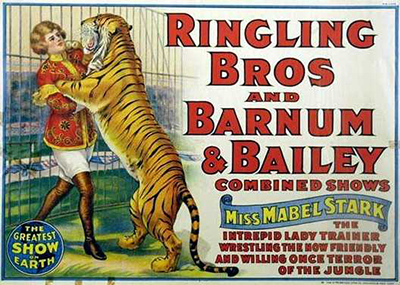 Stark, 110 lbs with yellow-dyed ringlets, got into working with large cats because she found nursing too stressful. She was an animal trainer for 50 years. She went through four husbands, finding men emotionally wounding. Tigers were her loves. She shared a cage with up to 20 tigers, lounging intimately with them. She claimed an almost mystical rapport with the animals, basing her act on the individual cats.
Of course, she did have, and flaunt, wounds from the cats. Stark, 110 lbs with yellow-dyed ringlets, got into working with large cats because she found nursing too stressful. She was an animal trainer for 50 years. She went through four husbands, finding men emotionally wounding. Tigers were her loves. She shared a cage with up to 20 tigers, lounging intimately with them. She claimed an almost mystical rapport with the animals, basing her act on the individual cats.
Of course, she did have, and flaunt, wounds from the cats. |
||||||||||||||||
1918 |
Hagenbeck-Wallace |
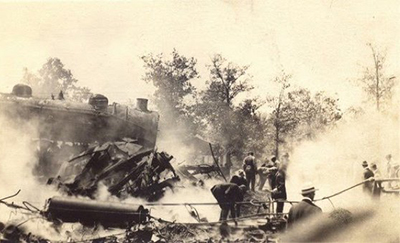 The Hagenbeck-Wallace Circus train was stopped on the tracks in Indiana. The performers, their families, and roustabouts were asleep. Flairs were set up to warn any approaching train. The Hagenbeck-Wallace Circus train was stopped on the tracks in Indiana. The performers, their families, and roustabouts were asleep. Flairs were set up to warn any approaching train.At 4:00 a.m. the engineer of a troop train (with no passengers) dozed at the wheel and slammed into the circus train. The wooden cars with kerosene lamps splintered and exploded: 86 people died, and at least 187 were wounded.
|
||||||||||||||||
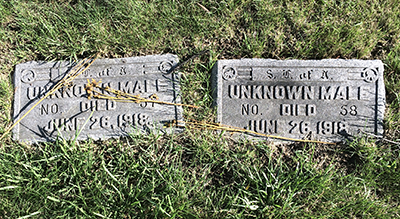 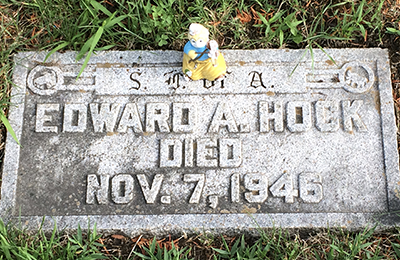 |
||||||||||||||||||
1919 |
Last Ringling Circus parade |
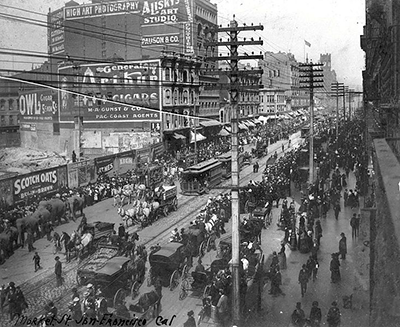 The parades snarled up traffic for hours, wore out the performers, and suffered accidents. In Boston a brake failed and 40 horses careened down Beacon Hill. And the very elaborate parades may have begun to suppress ticket sales at the lot. |
||||||||||||||||
1919 |
Clown Grock comes to New York |
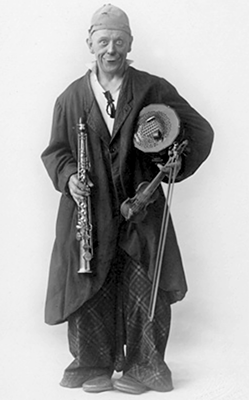 Charles Adrien Weltach, Swiss, knew he would be a clown the first time he saw one. At 23 he took the name Grock and apprenticed himself. In just three months, he learned to play the fiddle, clarinet, piano, drum, hurdy-gurdy, concertina, and to do pratfalls. He did contortions on a tightrope, working the continent and then in London in 1911.
Grock said that a clown overcomes little common annoyances but also transcends into something "strange and terrific." Charles Adrien Weltach, Swiss, knew he would be a clown the first time he saw one. At 23 he took the name Grock and apprenticed himself. In just three months, he learned to play the fiddle, clarinet, piano, drum, hurdy-gurdy, concertina, and to do pratfalls. He did contortions on a tightrope, working the continent and then in London in 1911.
Grock said that a clown overcomes little common annoyances but also transcends into something "strange and terrific." |
||||||||||||||||
1920 |
Codona, great trapeze artist |
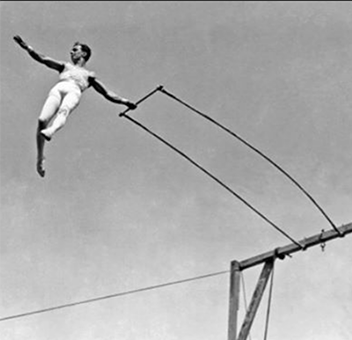 Afredo Codona did hundreds of triple somersaults.
At the end of the triple the flier has no control. The catcher must work with split-second precision. No one else could consistently do triples until the 1960s. Afredo Codona did hundreds of triple somersaults.
At the end of the triple the flier has no control. The catcher must work with split-second precision. No one else could consistently do triples until the 1960s.
Falling into a net usually saved an artist's life, but hitting the net wrong could cause rope burns and bruises, and sometimes broken bones, including broken necks. Codona ended his career by injuring himself falling into a net...after his heart was broken by Lillian Leitzel's fall. |
||||||||||||||||
1920 |
Women vote |
Suffrage for women was finally successful nationally. |
||||||||||||||||
1920s |
May Wirth, equestrienne |
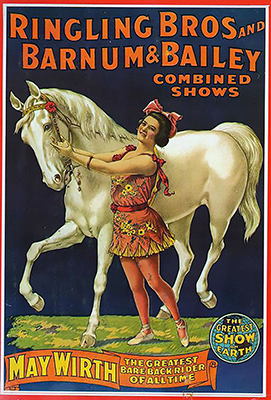 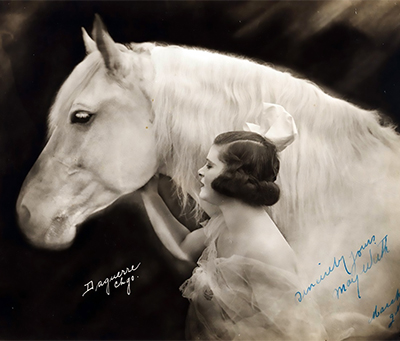 Wirth was the greatest equestrienne. One of her acts was to do layout somersaults from moving horse to moving horse. Wirth was the greatest equestrienne. One of her acts was to do layout somersaults from moving horse to moving horse. |
||||||||||||||||
1920s |
Cruel wild animal training |
Clown Robert Sherwood described a method for training cats: the trainer spent 60 to 90 days sitting near the cage, provoking a cat to lunge, then hitting the cat's nose with a whip when it did. Other trainers did similar things. Some elephants were injured. But many trainers maintained that they used only positive reinforcement techniques. |
||||||||||||||||
1922 |
Bird Millman ropewalks over Chicago |
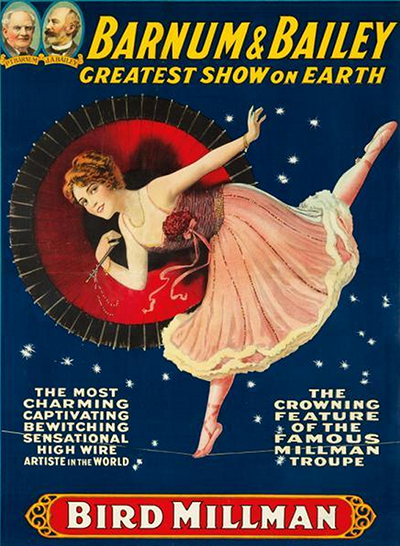 Bird Millman, née Jennadean Engleman, did this as a publicity stunt to send people to the circus. There she took the spotlight walking a 36' rope instead of the 18' standard. Her circus act was about finesse and flirtatious charm, not danger: she walked only 7' above the ground. She didn't use a balance bar or umbrella. Although she has an umbrella in this poster... maybe the artist just liked the looks of it. Bird Millman, née Jennadean Engleman, did this as a publicity stunt to send people to the circus. There she took the spotlight walking a 36' rope instead of the 18' standard. Her circus act was about finesse and flirtatious charm, not danger: she walked only 7' above the ground. She didn't use a balance bar or umbrella. Although she has an umbrella in this poster... maybe the artist just liked the looks of it. |
||||||||||||||||
1924 |
Con Colleano, "Latin" ropedancer |
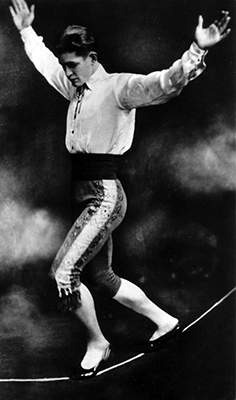
In 1924 Colleano, née Cornelius Sullivan, came to New York. He was known for his Latin persona, although he was actually from New South Wales. He learned his cape tricks from a matador. |
||||||||||||||||
1924 |
Giant Earle |
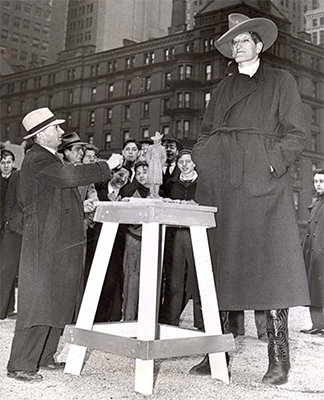
8'6" Jack Earle was a star both in the circus and in silent films, like 1924's Jack and the Beanstalk. |
||||||||||||||||
1924 |
Jack London vs. Ringling |
The writer urged boycotts of animal shows and support of humane societies. His club had 400,000 members. Initially Ringling convinced critics that their animals were humanely treated, but in 1925 they stopped the caged wild animal acts. They still kept elephants, giraffes, zebras, and sea lions. Mabel Stark was turned into a cowgirl. She hated it. |
||||||||||||||||
1925 |
Shrine Circus has three rings |
Many circus stars have performed in the Shriners’ circuses. The proceeds supported the Shriners, who said they supported local hospitals. They gave away many free tickets. |
||||||||||||||||
1926 |
The last Ringling brother takes over |
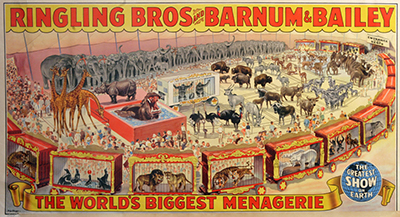 In 1925, the Ringling circus consisted of:
In 1925, the Ringling circus consisted of:
|
||||||||||||||||
1926 |
Giant cannon |
Zacchini proposed shooting soldiers with parachutes over enemy lines in WWI. There were obvious problems with this, but the idea grew in him. Hugo and Bruno Zacchini were owners of a small Italian circus. Hugo's son Edmondo had a degree in mechanical engineering and invented a way to shoot his brother Vittorio 100 feet, 50 feet high. They kept the mechanism secret for decades.
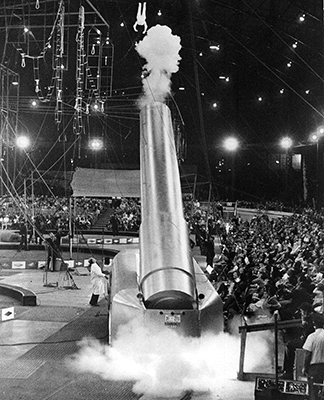 By the end of the 1950s Zacchinis were being shot from cannons all over America. By the end of the 1950s Zacchinis were being shot from cannons all over America. |
||||||||||||||||
1927 |
Fake sacred white elephant |
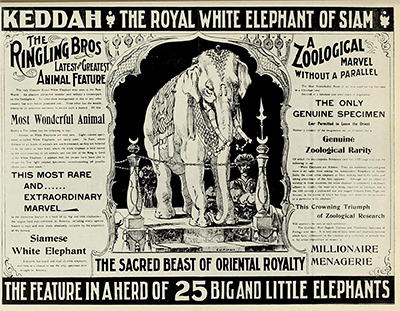
It was easier to fool people in those days... or was it? Think fake news. It was easier to fool most of the people... |
||||||||||||||||
1927 |
Sarasota, Florida |
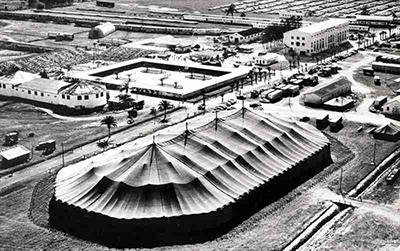
Sarasota became Ringling's winter quarters. It now boasts an extensive circus museum. |
||||||||||||||||
1927 |
Sideshow suicide |
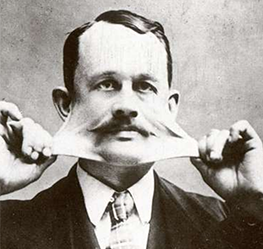 Elastic Skin Joe killed himself with strychnine before a crowd when the tattooed lady rebuffed him.
Elastic Skin Joe killed himself with strychnine before a crowd when the tattooed lady rebuffed him. |
||||||||||||||||
1928 |
Ringmasters don a red coat |
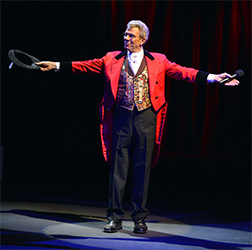 The red tails were worn by George Claude Lockhart. The 18th century riding habit costume refers back to the day when the ringmaster directed the equestrian show. The bandmaster then became the announcer, a master of hyperbole. The red tails were worn by George Claude Lockhart. The 18th century riding habit costume refers back to the day when the ringmaster directed the equestrian show. The bandmaster then became the announcer, a master of hyperbole. |
||||||||||||||||
1928 |
The Flying Wallendas debut in Madison Square Garden |
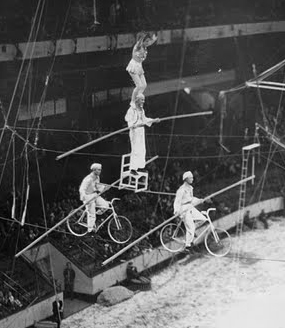 The Wallendas were a circus family since the 18th century. They started as travelling acrobats and jugglers, but by the 20th century they were performing in the air. Karl, born in Germany in 1905, started on the trapeze with his father then became a wirewalker. He did a handstand on his partners’ shoulders on the wire.
The Wallendas were a circus family since the 18th century. They started as travelling acrobats and jugglers, but by the 20th century they were performing in the air. Karl, born in Germany in 1905, started on the trapeze with his father then became a wirewalker. He did a handstand on his partners’ shoulders on the wire.Karl, his brother Herman, and additional family members formed pyramids that walked the wire, first with four men then with seven. 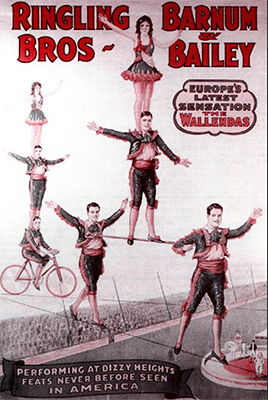 In their 1928 New York debut they received a 15-minute ovation. In their 1928 New York debut they received a 15-minute ovation. They were performing at the onset of the infamous Hartford circus fire in 1944. In 1962 in Detroit their high wire pyramid had seven ropewalkers on three tiers when nephew Dieter Schepp said "I can't hold on any longer!" and the pyramid collapsed. Three men fell: Schepp and another were killed, the third was paralyzed (but performed with his disability). 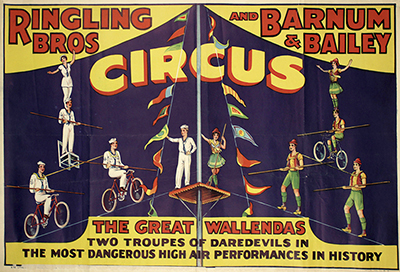 After 1962 Karl's wife prayed in a back room instead of watching the act. After 1962 Karl's wife prayed in a back room instead of watching the act. Such accidents made the danger real to audiences, and harder for the performers to ignore. But Karl kept performing. He said, "Life is on the wire. The rest is just waiting." In 1978 73-year-old patriarch Karl Wallenda was killed walking between two hotels in Puerto Rico, a stunt to sell circus tickets. A strong gust of wind swayed the wire and made him lose balance. He fell 100 feet to his death. But the Wallendas, who have been an inspiration to many artists, are still performing. |
||||||||||||||||
1929 |
Ringling buys five circuses. Bad timing, neh? |
The American Circus Corporation, owned by four big circuses, was contracted to open at Madison Square Garden for the 1930 season. John Ringling was mad, so he bought the circuses with a $2,000,000 note... and then the market crashed. The Ringling circus survived but couldn't pay its debt. Sam Gumpertz, a friend but not a family member, forced John Ringling out in 1932, leaving him feeling betrayed. John died in 1936. |
||||||||||||||||
1930s |
Martians and exotic earthlings are exploited |
Racial bias was less in circuses than outside, but Ringling cashed in on the public's prejudice. People flocked to see: "Ubangi Lipped Men" came from French Equatorial Africa. They were lured with promises of salt and jewelry. They brought the largest crowds in Ringling history. The men took control of the situation, including renegotiating their payment: after two years they went home and bought a cattle ranch. |
||||||||||||||||
1931 |
Lillian Leitzel falls |
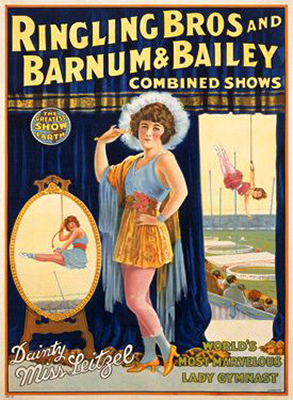 Dainty Lillian Leitzel, Queen of the Roman Rings, was the biggest American circus star ever. Her luxurious train car had a baby grand piano (she had originally considered becoming a concert pianist), and she had her own fancy dressing tent.
Dainty Lillian Leitzel, Queen of the Roman Rings, was the biggest American circus star ever. Her luxurious train car had a baby grand piano (she had originally considered becoming a concert pianist), and she had her own fancy dressing tent.
Leitzel was a third generation aerialist, born in Germany in 1892. When she was nine she joined in an aerial ballet. The tiny artist (only 4'9" when adult) stole the show and the circus became her whole life. She climbed up the web of ropes above the middle ring, and grabbed the Roman rings. After doing some tricks, she grabbed a rope and was raised to the top of the tent. She did not have a net.
Alexander Calder loved seeing Leitzel in the spotlight. You can get a glimpse of Leitzel's act in the movie The Greatest Show on Earth. |
||||||||||||||||
1931 |
Roaring beasts are back! |
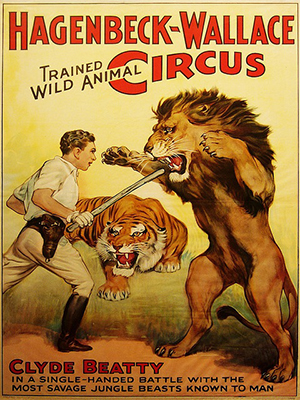 Clyde Beatty, born in 1903, ran away to join the circus. By 15 he was working as a cage boy at Howe's Great London Circus. It took two years before he got to perform with his beloved cats. In 1925 he joined the Hagenbeck–Wallace Circus and took over the cat act, 25 lions and tigers. He developed a "fighting" style of show, very fast and seemingly confrontational.
Clyde Beatty, born in 1903, ran away to join the circus. By 15 he was working as a cage boy at Howe's Great London Circus. It took two years before he got to perform with his beloved cats. In 1925 he joined the Hagenbeck–Wallace Circus and took over the cat act, 25 lions and tigers. He developed a "fighting" style of show, very fast and seemingly confrontational.
Beatty was badly mauled by a lion and nearly died in 1932. He was working for Ringling: North postponed the opening show of the season until Beatty recovered enough to perform. Usually circuses didn't cover medical expenses, but Ringling did this time. Beatty was 5'7". He wore a hunter costume and employed a pistol with blanks and a whip with a popper. He preferred wild-caught, ferocious cats. Beatty believed that one day man will commune with animals. He also felt closer to beasts than non-white people. He claimed that among the Ubangi he was considered a god. |
||||||||||||||||
1931 |
Noose disaster |
 Alois Peters, "The Man Who Hangs Himself," had an act in which he jumped from a 75' platform with a noose around his neck. During one show things went badly awry. |
||||||||||||||||
1932 |
Freaks movie |
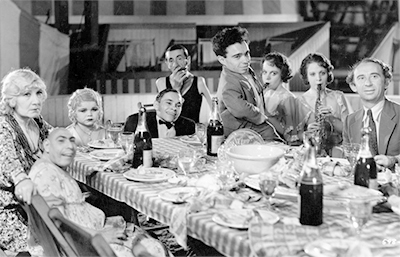 In Freaks Tod Brownings presented the conventionally beautiful actors as the ugly characters. The movie cast actual prodigies, and included unforgettable scenes. It became a cult classic but was not well received when it came out: it ruined Brownings's career. In Freaks Tod Brownings presented the conventionally beautiful actors as the ugly characters. The movie cast actual prodigies, and included unforgettable scenes. It became a cult classic but was not well received when it came out: it ruined Brownings's career.
|
||||||||||||||||
1933 |
Clown Emmett Kelly |
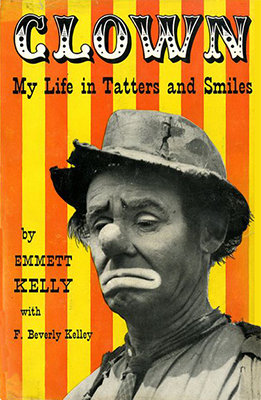
Depression hobo "Weary Willie" was a star clown until the 1960s. He was partly inspired by a cartoon Kelly drew years ago. He started in the circus as an aerialist.
|
||||||||||||||||
1933 |
Ringling advertises an elephant brass band |
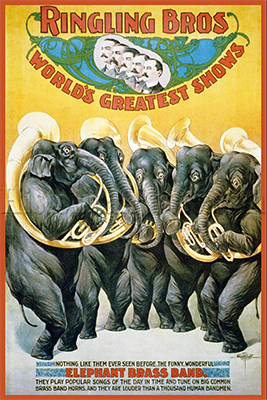
I wonder what this sounded like. |
||||||||||||||||
1933 |
Clowns Without Borders |
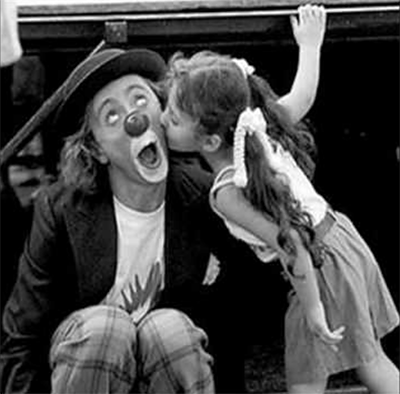 This international group was founded when clown Tortell Poltrona went into a refugee camp in Barcelona. The organization is still active, now associated with UNESCO. This international group was founded when clown Tortell Poltrona went into a refugee camp in Barcelona. The organization is still active, now associated with UNESCO. |
||||||||||||||||
1934 |
Popular band music is played in the circus |
|||||||||||||||||
1934 |
Last "parade of freaks" in spec |
|||||||||||||||||
1936 |
"Major Mite" |
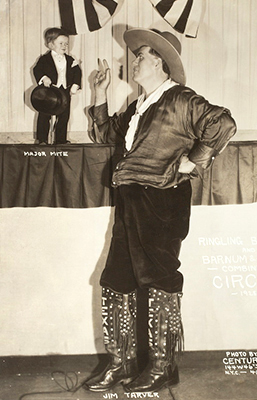
Clarence Howerton, 3'6" tall, also appeared in The Wizard of Oz. |
||||||||||||||||
1937 |
Five rings! |
Ringling had five rings plus two stages. |
||||||||||||||||
1938 |
Ringling is back in the family |
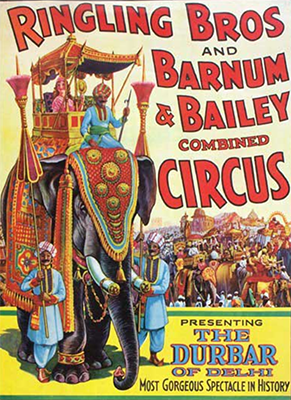 Nephews John Ringling North and Henry North wrested back control over the circus. John ran the show. The board gave him five years to prove himself.
Nephews John Ringling North and Henry North wrested back control over the circus. John ran the show. The board gave him five years to prove himself.The Norths believed that people were not nostalgic about the past and were not too hopeful about the future, that the depression had created "world woe." Besides, people had cars, had seen movies, and were more sophisticated. The North brothers moved away from a show consisting of a hodge-podge of unrelated acts relying on tinsel and glitter. They created spectacles with unity of theme, aiming for "an infusion of Barnumesque showmanship tuned to the age of radio." 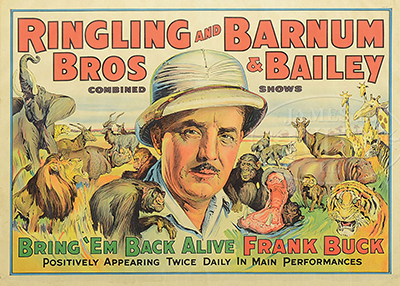 The Norths focused on glamour instead of danger, with harmonious costumes, aerial ballets, and narrative stories. When the theme was India the band wore Bengal Lancer uniforms and the dancers wore translucent saris. Frank Buck, the actor and animal collector, wore a pith helmet. (Frank Buck dressed as and claimed to be an animal collector, but he actually got most of his animals from Germany's Hagenbeck firm.) The Norths focused on glamour instead of danger, with harmonious costumes, aerial ballets, and narrative stories. When the theme was India the band wore Bengal Lancer uniforms and the dancers wore translucent saris. Frank Buck, the actor and animal collector, wore a pith helmet. (Frank Buck dressed as and claimed to be an animal collector, but he actually got most of his animals from Germany's Hagenbeck firm.)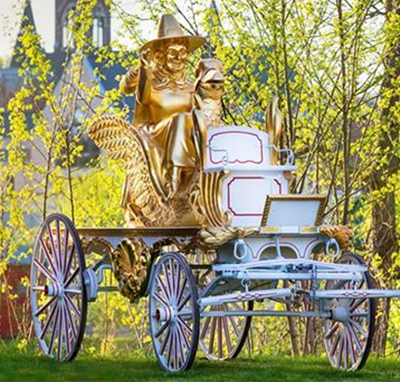 One year the theme was Mother Goose. One year the theme was Mother Goose.
The Kentucky Derby was the theme just before the war, when the audience was feeling prosperous again. |
||||||||||||||||
1938 |
Gargantua |
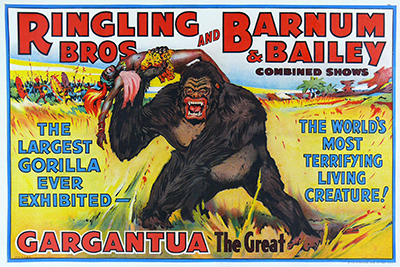 Gargantua, née Buddy, was a very large gorilla who never performed but was heavily advertised and displayed until 1949. Gargantua, née Buddy, was a very large gorilla who never performed but was heavily advertised and displayed until 1949. |
||||||||||||||||
1938 |
Lucio Cristiani |
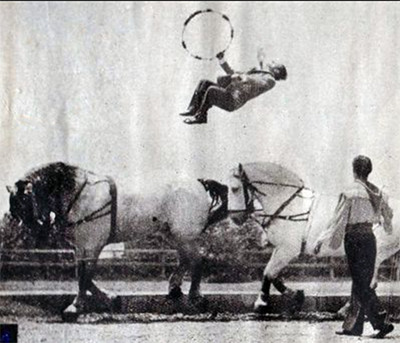 Equestrian Cristiani did a backward somersault over an intermediate horse. Since they were moving in the ring, he had to calculate the diagonal. Equestrian Cristiani did a backward somersault over an intermediate horse. Since they were moving in the ring, he had to calculate the diagonal.
|
||||||||||||||||
1938 |
Animal hypnotist? |
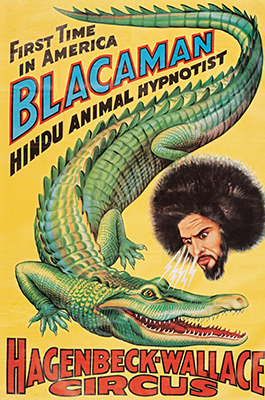
Hindu Blacaman claimed he hypnotized cats and other beasts. |
||||||||||||||||
1939–1945 |
World War II |
America entered the war after the Pearl Harbor attack in 1941. |
||||||||||||||||
1939 |
Airplanes in the big top |
Women hung from trapezes under miniature rotating airplanes (that were not actually free flying). Since air travel was considered risky, this felt dangerous. |
||||||||||||||||
1939 |
Changes to the tent |
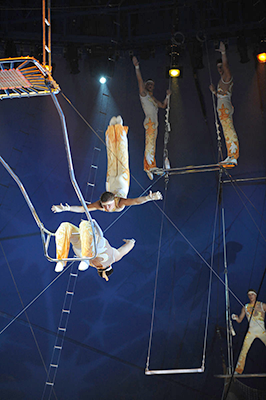
The big top became less oval so people at the ends could see the center ring. The stages were gone, but there were still very few solo acts, and often as many as 10 acts at once. The inside of the tent was painted dark blue so that the lighting effects worked in the day. They even tried to air condition the tent. |
||||||||||||||||
1940 |
Animal trainer as cat complicit |
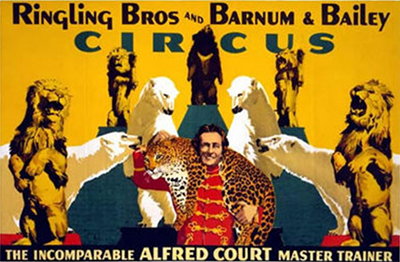 Alfred Court lay back with the cats.
Alfred Court lay back with the cats.Court was a French champion gymnast in school, but at 16 he ran away and gradually built his role in the circus world. He taught himself animal training in Mexico. In 1940 he joined Ringling with his huge animal act: 14 assistants working with 60 animals in 18 species presented "Peace in the Jungle." |
||||||||||||||||
1941 |
FDR says the show must go on |
North considered closing the circus for the duration of the war, but Roosevelt gave deferments to the men needed for the show because the circus raised morale. In 1942 giant banners of FDR graced the finale. |
||||||||||||||||
1941 |
Dumbo |
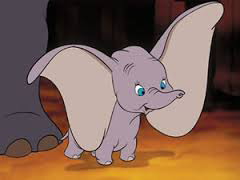
Walt Disney both celebrated and attacked the circus. |
||||||||||||||||
1942 |
Amazing elephant acts |
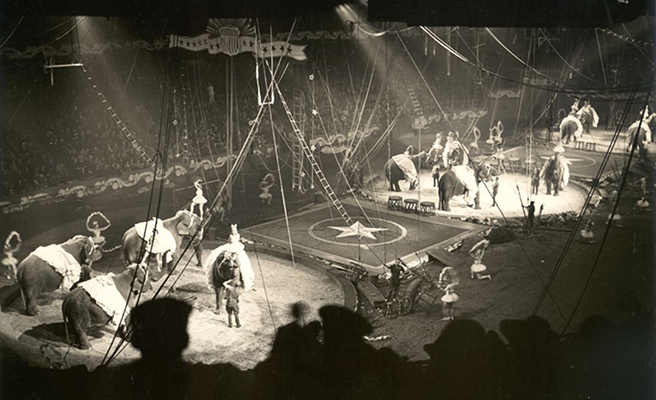
George Ballantine choreographed a "pachydermal extravaganza" to an Igor Stravinsky score. 50 ballerinas and 50 elephants wore pink tutus. Ballantine's wife danced on the premier elephant. Designer Miles White created costumes for a holiday-themed show. In the spec climax, Santa was pulled by elephants costumed as reindeer. |
||||||||||||||||
1943 |
John Ringling North is out |
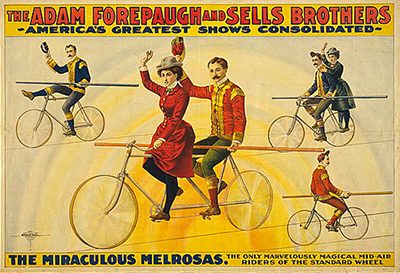 North's cousin Robert Ringling took over the show. He was into 1890s stuff: nostalgia, sawdust, pink lemonade, turn of the century clothes, "Bicycle Built for Two." He also featured patriotism, parading the cast with international royalty, U.S. Presidents, and Uncle Sam costumes. He ended the show with the songs of the different U.S. armed forces. 14,000 people bought war bonds in exchange for tickets.
North's cousin Robert Ringling took over the show. He was into 1890s stuff: nostalgia, sawdust, pink lemonade, turn of the century clothes, "Bicycle Built for Two." He also featured patriotism, parading the cast with international royalty, U.S. Presidents, and Uncle Sam costumes. He ended the show with the songs of the different U.S. armed forces. 14,000 people bought war bonds in exchange for tickets. |
||||||||||||||||
1944 |
The Hartford fire |
The Flying Wallendas were performing on the high wire over a crowd of 8,000. Somebody intentionally ignited the big top. 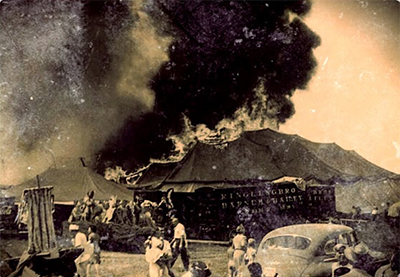 The tent had been waterproofed using paraffin dissolved in gas. When the tent caught fire, it dropped like napalm. In eight minutes the big top was consumed. The tent had been waterproofed using paraffin dissolved in gas. When the tent caught fire, it dropped like napalm. In eight minutes the big top was consumed.
Two of the exits were blocked by cages being repositioned for the show. (The circus was undermanned because of the war. Many of the roustabouts were untrained teenagers.) |
||||||||||||||||
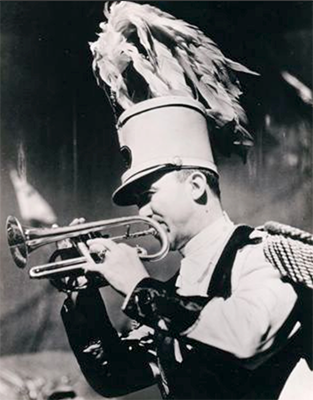 Merle Evans, who was Ringling's band director from 1919 to 1969, saved lives at the Hartford fire by quickly getting the band to play the “disaster march" (Sousa’s Stars and Stripes Forever), and to keep playing it. The band evacuated the tent at the last possible moment and kept playing outside. Merle Evans, who was Ringling's band director from 1919 to 1969, saved lives at the Hartford fire by quickly getting the band to play the “disaster march" (Sousa’s Stars and Stripes Forever), and to keep playing it. The band evacuated the tent at the last possible moment and kept playing outside.
Ringling paid out $5 million to the victim's families and started using fireproofing on their canvas. Ever after this event, circuses performing in Connecticut had to pay $7,000 for firemen standing by with loaded hoses. |
||||||||||||||||||
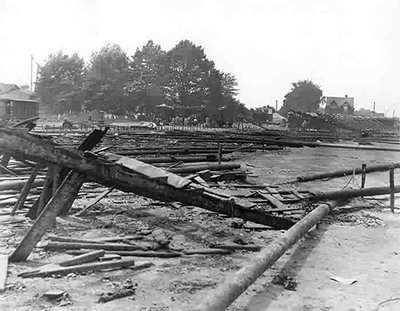 Five of Robert Ringling's associates were arrested for involuntary manslaughter. Bail was met and they regrouped in Sarasota. Five of Robert Ringling's associates were arrested for involuntary manslaughter. Bail was met and they regrouped in Sarasota.
|
||||||||||||||||||
1945 |
VE Day |
The circus celebrated in Madison Square Garden. |
||||||||||||||||
1945 |
Clyde Beatty Circus |
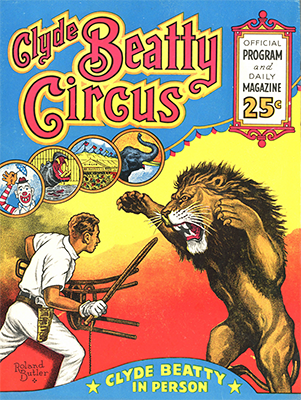
Beatty was a famous animal trainer who bought the Wallace Brothers Circus and the Russell Bros Pan Pacific Circus. By 1947 he was the sole owner, and his circus travelled by rail.
|
||||||||||||||||
1946 |
Bikinis shock |
French bathing suits were shocking, but similar scanty costumes had long been accepted in the circus. |
||||||||||||||||
1946 |
Billy Smart's New World Circus |
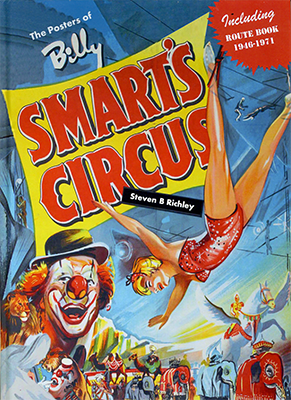
Smart had 11 children who all had parts in the show. By 1958 the tent seated 6,000 and was televised in Britain. Smart died in 1966: in 1993 his grandchildren revived a one-ring circus. |
||||||||||||||||
1948 |
Ringling is profitable again... |
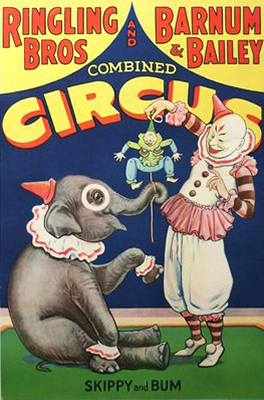
...but it became more and more a spectacle geared to children. The clowns were more exaggerated, and the star performers were not well promoted. |
||||||||||||||||
1948 |
Ringling Museum of the American Circus |
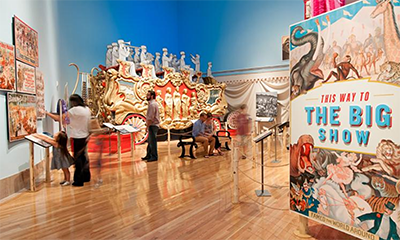 Sarasota had been the winter quarters for Ringling since 1927, so the opulent and complex museum ended up in Florida. Sarasota had been the winter quarters for Ringling since 1927, so the opulent and complex museum ended up in Florida. |
||||||||||||||||
1949 |
The Girl in the Moon |
A special aerial ballet... |
||||||||||||||||
1950 |
The Human Corkscrew |
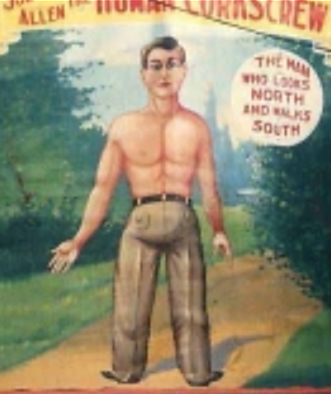 Joe Allen, "The man who looks north but walks south," reflected that in his career he wiggled through a 13.5" hoop 25,000 times. Joe Allen, "The man who looks north but walks south," reflected that in his career he wiggled through a 13.5" hoop 25,000 times. |
||||||||||||||||
1950s |
Most homes get televisions |
People have access to special phenomena in new ways, making sideshows less compelling. |
||||||||||||||||
1950s |
Dieter Tasso |
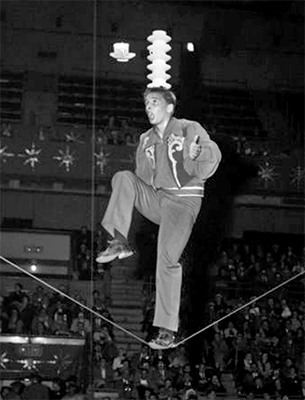 Up on a wire, he tossed cups and saucers onto his head using his foot. When he got too old for this he turned it into humor and was a big hit. Up on a wire, he tossed cups and saucers onto his head using his foot. When he got too old for this he turned it into humor and was a big hit. |
||||||||||||||||
Mid 20th century |
New Wave clowns |
The tradition of whiteface and Auguste clowns declined. Some of the new, political clowns were like ancient jesters, telling truth to power. They strived to make people think instead of just making them laugh. The new clowns were sly tricksters. 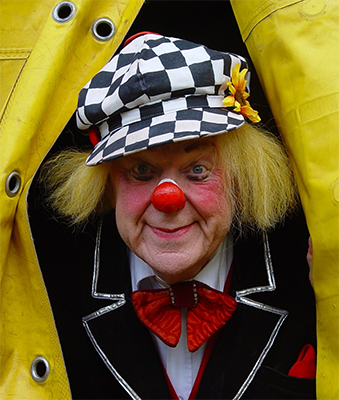 However, Oleg Popov, the Moscow star clown, created a gentle, wistful persona. He graduated in 1949 from the Russian State School of Circus and Variety Show Arts, where he spent five years working six days a week to perfect his craft. |
||||||||||||||||
1952 |
Broadway designer creates circus costumes |
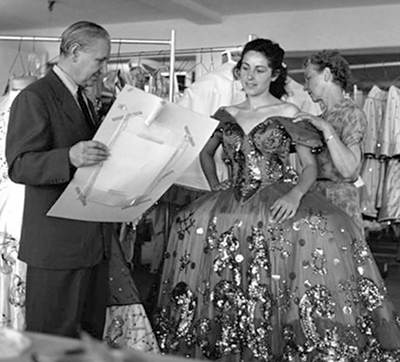 Tony award winning Miles White, who designed for Oklahoma and Carousel, designed "ancient Egyptian" dancer's costumes. He designed circus costumes similar to Moulin Rouge and Follies Bergére costumes. Tony award winning Miles White, who designed for Oklahoma and Carousel, designed "ancient Egyptian" dancer's costumes. He designed circus costumes similar to Moulin Rouge and Follies Bergére costumes. |
||||||||||||||||
1952 |
Tie-in to The Greatest Show on Earth |
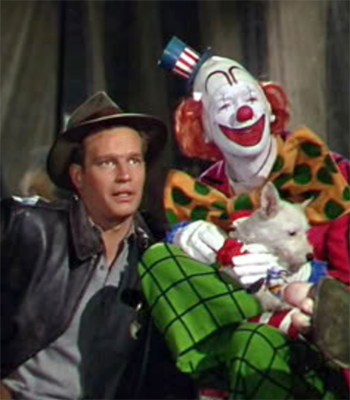 Cecil B. DeMille's movie may not be a great show: but it does include actual circus acts. It was supported by Ringling in an attempt to draw visitors to the circus. Cecil B. DeMille's movie may not be a great show: but it does include actual circus acts. It was supported by Ringling in an attempt to draw visitors to the circus. |
||||||||||||||||
1955 |
Disneyland opens |
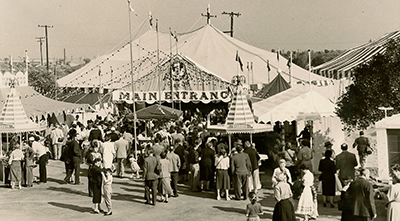 |
||||||||||||||||
1955–1975 |
Vietnam War |
|||||||||||||||||
1956 |
Last Ringling outdoor tent shows |
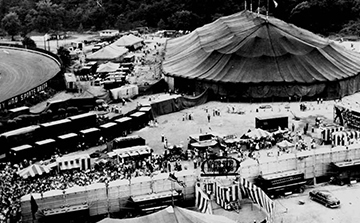 |
||||||||||||||||
1956 |
Rock 'n Roll |
Ringling presented rock music with "authentic" Zulu dancers. |
||||||||||||||||
1957 |
Clyde Beatty–Cole Brothers Circus |
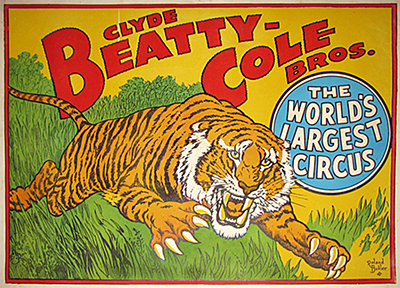 John Ringling North declared the big top dead, but people he had fired for skimming differed about the demise of the tents. John Ringling North declared the big top dead, but people he had fired for skimming differed about the demise of the tents.The Clyde Beatty Circus was purchased by two stage circus personalities and two businessmen. The circus went from trains to trucks. They also purchased the use of the title Cole Brothers. |
||||||||||||||||
c. 1958 |
My first circus |
It was a Ringling extravaganza in an Ohio State Fairground arena. I loved it, but was distressed that Mother wouldn't buy me a fabulous balloon, a mouse-head-shaped balloon inside a transparent balloon. |
||||||||||||||||
1959 |
Circus World in Baraboo |
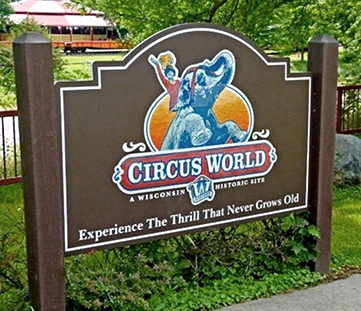
A circus museum opened in Baraboo, Wisconsin, home to Ringling's original winter quarters. |
||||||||||||||||
1959 |
Sugar-Brown family |
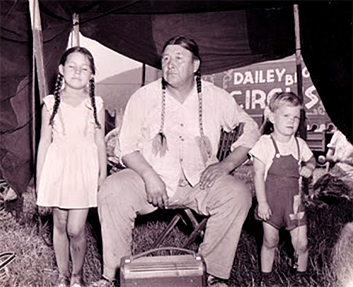
|
||||||||||||||||
1960s |
Most sideshows close down |
What happened to those who depended on them? Ringling continued to have aspects of sideshows into the 21st century. |
||||||||||||||||
1960s |
Audiences don't respond to old animal acts |
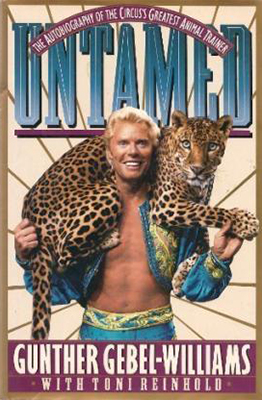
Europeans like Gunther Gebel-Williams and Cole Circus's Joseph Marcam presented non-confrontational interactions. |
||||||||||||||||
1960s |
Trapeze triple somersaults |
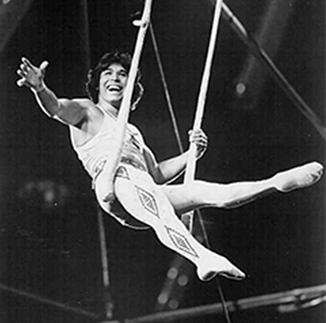 Tito Gasona even did them blindfolded. He attempted a quadruple. Tito Gasona even did them blindfolded. He attempted a quadruple. |
||||||||||||||||
1963 |
Kennedy and King |
John F. Kennedy was assassinated; Martin Luther King declared "I Have a Dream." |
||||||||||||||||
1966 |
Movies catch up to the circus... |
...in allowing women to show their bellies. (The Motion Picture Association of America forbade this formerly.) |
||||||||||||||||
1967 |
Feld buys Ringling |
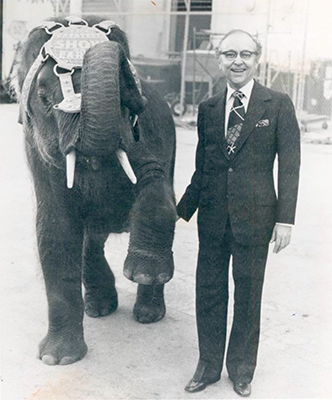 Irvin Feld, a producer of rock shows, and his brother Israel purchased Ringling (with Judge Roy Mark Hofheinz and Richard C. Blum). Irvin Feld, a producer of rock shows, and his brother Israel purchased Ringling (with Judge Roy Mark Hofheinz and Richard C. Blum). |
||||||||||||||||
1968 |
A year that lives in infamy |
Tet offensive. My Lai massacre. Those assassinations. That Democratic convention. Kent State was a couple of years later but protests and acrimony were rampant in 68.
|
||||||||||||||||
1968 |
Clown College |
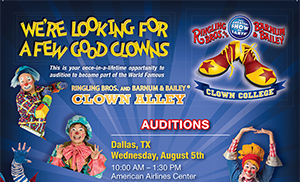 Ringling's Clown College offered classes until 1998. Actor Bill Irwin and Penn Jillette (of Penn & Teller) attended. Ringling's Clown College offered classes until 1998. Actor Bill Irwin and Penn Jillette (of Penn & Teller) attended.
|
||||||||||||||||
|
|
I went as far as to get an application, but I was intimidated by the questions on it, like experience with juggling. |
|||||||||||||||||
1968 |
Circus Circus Hotel |
Las Vegas created the largest permanent big top anywhere. The hotel was immortalized by Hunter Thompson in 1972 in his book Fear and Loathing in Las Vegas. |
||||||||||||||||
1969 |
Ringling gets Gunther Gebel-Williams |
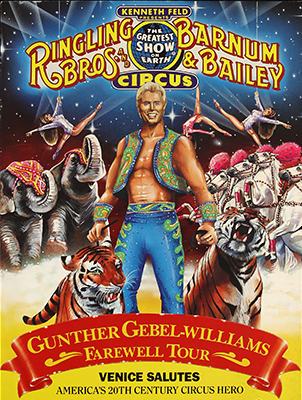 Audiences appreciated his close relationship with animals...and his rock-star persona. Audiences appreciated his close relationship with animals...and his rock-star persona. He was small and slim but muscular. He did not use a whip, pistol, or chair. He was never accused of animal cruelty during the performances, but there were some who did not trust his training methods. Gebel-Williams joined the circus at 12 years old. He died in 2001, the last circus animal master. |
||||||||||||||||
1970 |
Pickle Family Circus |
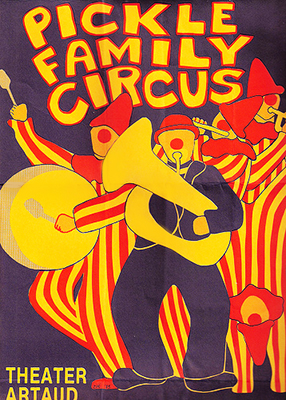 Larry Pisoni moved to San Francisco and started his circus with an NEA grant. It was a family affair, with wife Peggy Snider and their babies Gypsy and Lorenzo. Larry Pisoni moved to San Francisco and started his circus with an NEA grant. It was a family affair, with wife Peggy Snider and their babies Gypsy and Lorenzo.
Pickle was a not-for-profit co-op. Everyone at Pickle helped lots of ways. But the meetings were chaotic and they gradually had the sorts of problems co-ops often have. |
||||||||||||||||
1971 |
Mattel buys Ringling |
The toy company paid $40 million. |
||||||||||||||||
1976 |
Mr. Bill Goes to the Circus |
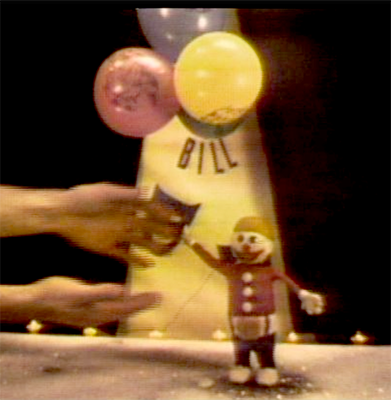 Walter Williams had Mr. Bill shot out of a cannon on Saturday Night Live. Walter Williams had Mr. Bill shot out of a cannon on Saturday Night Live.
|
||||||||||||||||
1977 |
The Big Apple Circus |
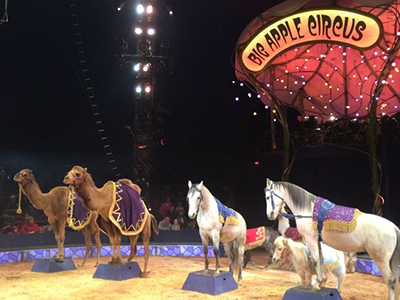 Paul Binder and Michael Christensen traveled around Europe as street performers. They spent time with Nouveau Cirque, then returned to New York and opened a European-like circus, intimate and artistic, with just one ring. The Big Apple related to circuses' historic roots and rituals, demonstrating personal triumph over obstacles. Paul Binder and Michael Christensen traveled around Europe as street performers. They spent time with Nouveau Cirque, then returned to New York and opened a European-like circus, intimate and artistic, with just one ring. The Big Apple related to circuses' historic roots and rituals, demonstrating personal triumph over obstacles..jpg) Binder had been in a San Francisco mime troupe, and had worked behind the scenes on television. |
||||||||||||||||
1978 |
Circus Oz |
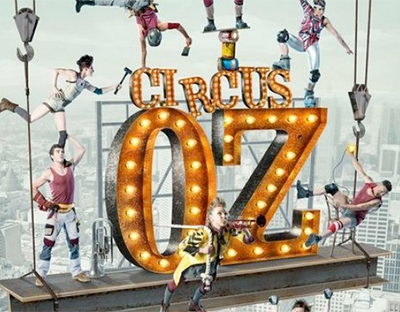 The "non-sexist, non-racist, anti-nuke" circus opened in Melbourne. The 12 performers had no animals, promoted aboriginal rights, and featured rock and roll. They were chaotic and subversive, traveling the world, performing in refugee camps and indigenous communities. The "non-sexist, non-racist, anti-nuke" circus opened in Melbourne. The 12 performers had no animals, promoted aboriginal rights, and featured rock and roll. They were chaotic and subversive, traveling the world, performing in refugee camps and indigenous communities. |
||||||||||||||||
1980 |
PETA |
People for the Ethical Treatment of Animals was founded. |
||||||||||||||||
1981 |
Beatty-Cole circus almost stops traveling |
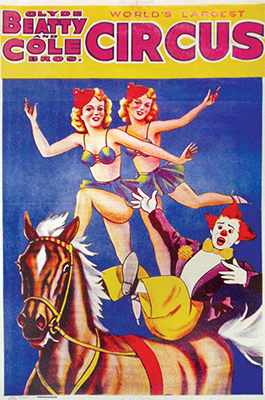
The circus was donated to Florida. Johnny Pugh had been managing the circus since the 1960s. He bought it from Florida and changed the name back to Cole Brothers Circus. |
||||||||||||||||
1982 |
A quadruple on the trapeze |
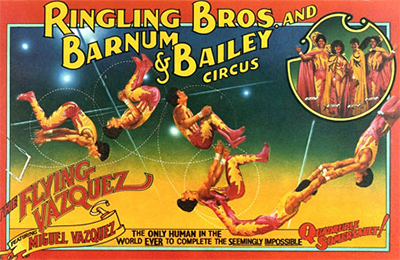 Miguel Vázquez did a quad in practice in 1981. He did it again for a Ringling audience of 1,700. It made page one of the New York Times. He said it felt like riding on a roller coaster. This is also an amazing feat on the part of his brother who caught Miguel flying at 75 mph, but the flier always got most of the glory. Miguel Vázquez did a quad in practice in 1981. He did it again for a Ringling audience of 1,700. It made page one of the New York Times. He said it felt like riding on a roller coaster. This is also an amazing feat on the part of his brother who caught Miguel flying at 75 mph, but the flier always got most of the glory. |
||||||||||||||||
1982 |
Felds buy Ringling back |
Irvin Feld and his son Kenneth got Ringling back. They also owned ice shows. Their Ringling shows were very nostalgia centered. |
||||||||||||||||
1984 |
Cirque du Soleil |
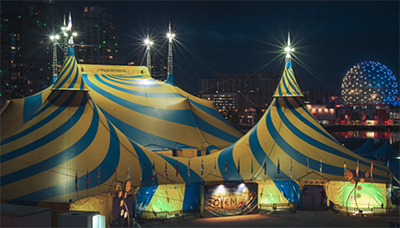 Street performers Guy Laliberté and Gilles Ste-Croix opened the Cirque in Quebec City as part of the celebration of the 450th anniversary of the discovery of Canada. They eventually chose the name that means Circus of the Sun, and headquartered it in Montreal. Animals were excluded because they were too expensive. Street performers Guy Laliberté and Gilles Ste-Croix opened the Cirque in Quebec City as part of the celebration of the 450th anniversary of the discovery of Canada. They eventually chose the name that means Circus of the Sun, and headquartered it in Montreal. Animals were excluded because they were too expensive.In 1984 they hired Guy Caron from the National Circus School to re-create it as a "proper circus." They put emphasis on story line and spectacles, not the performers who were hidden under make-up and interchangeable. They used a very loud synthesizer score and featured special effects with precision lighting. In 1987 the extravaganza opened in Los Angeles. Critics said the clowns were considered weak, but the aerialists were stunning. It was mostly an adult audience. They were a big hit: and a big business. The sense of intimacy originally valued was gone. There was no sense of family or camaraderie among the cast.
|
||||||||||||||||
1986 |
Stephen King's It |
The novel caused an exponential increase in coulrophobia, the irrational fear of clowns. And in 2017 the new movie... ("Coulro" is a Greek word meaning "one who goes on stilts.") |
||||||||||||||||
1986 |
Circus Archaos |
Pierrot Bidon was a tightrope walker for 10 years before starting Circus Archaos. It reflected violence and dehumanization. It was more like a slasher movie or scary street theater than a circus. |
||||||||||||||||
1990s |
Damn the circus! |
PETA and others campaigned against having wild animals in circuses. |
||||||||||||||||
1992 |
Lilov gets a green card |
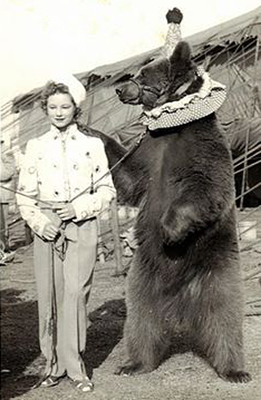 Venko Lilov from Bulgaria took bears from performing as costumed, dancing clowns to performing more sports-like, gymnastic skills. He observed the bears, and when they did something that could fit into an act, he rewarded them. Venko Lilov from Bulgaria took bears from performing as costumed, dancing clowns to performing more sports-like, gymnastic skills. He observed the bears, and when they did something that could fit into an act, he rewarded them. 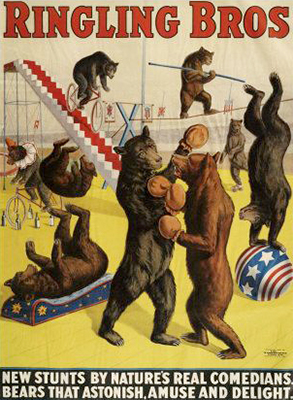 Venko and his wife and son convinced Miami immigration officials that America has no other "bear wrestlers," and that we needed some. Venko and his wife and son convinced Miami immigration officials that America has no other "bear wrestlers," and that we needed some. |
||||||||||||||||
1993 |
Writer joins circus for a season |
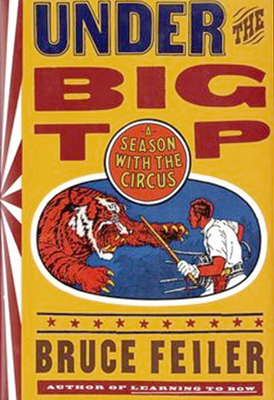 Writer Bruce Feiler was a clown for a season with the Clyde Beatty–Cole Brothers Circus, then the largest tented circus in the world. Among the many events described in his book Under the Big Top was a drunk man sneaking into the elephant enclosure at night, startling the elephant into fatally squeezing the man against a trailer. Writer Bruce Feiler was a clown for a season with the Clyde Beatty–Cole Brothers Circus, then the largest tented circus in the world. Among the many events described in his book Under the Big Top was a drunk man sneaking into the elephant enclosure at night, startling the elephant into fatally squeezing the man against a trailer. 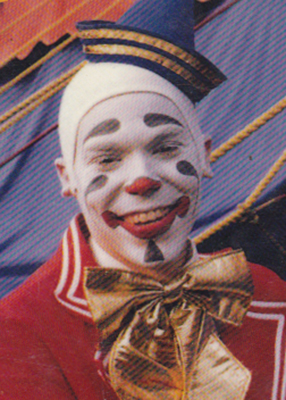 The press blamed this incident on the elephant so it's good that Feiler straightened out the story. The press blamed this incident on the elephant so it's good that Feiler straightened out the story. |
||||||||||||||||
|
|
||||||||||||||||||
1997–1999 |
Ashley dances with the Ringling circus |
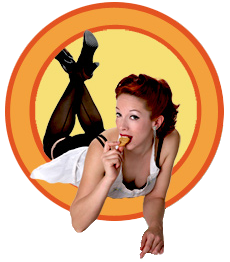 My dancing
friend Ashley Simone wearied of her life in Chicago and ended up auditioning for Ringling. She rode the rails for two seasons, and has been telling me all about it.
The dancers' car had 16 women, eight dancers and eight Russian acrobats. Each had a tiny compartment with a bed, a little storage unit, and just enough room to stand. The bed could be folded up to make a chair and table. The second year was nicer, with a dorm-size refrigerator and a microwave (and Ashley, who is now a chef, added a hot plate). The car had a shared bathroom including a shower, but they couldn't use it when the train was moving as the water had to be conserved. When they were settled in at a site they hoped that the train wouldn't stay on one track so that their friends wouldn't end up a long way away. My dancing
friend Ashley Simone wearied of her life in Chicago and ended up auditioning for Ringling. She rode the rails for two seasons, and has been telling me all about it.
The dancers' car had 16 women, eight dancers and eight Russian acrobats. Each had a tiny compartment with a bed, a little storage unit, and just enough room to stand. The bed could be folded up to make a chair and table. The second year was nicer, with a dorm-size refrigerator and a microwave (and Ashley, who is now a chef, added a hot plate). The car had a shared bathroom including a shower, but they couldn't use it when the train was moving as the water had to be conserved. When they were settled in at a site they hoped that the train wouldn't stay on one track so that their friends wouldn't end up a long way away.
Next to the dancers' car was the clown car: the clowns and dancers still work harder than anyone else as they entertain during rigging changes. There were three shows a day. Each show had an intermission: there were five or six costume changes for the dancers. The dancers worked very hard for their pay of $325 a week (which didn't include meals, there was no food tent like in the old days). They had to cart their personal clothes to laundromats. Ashley thought there were about 350 people traveling with the show, including a doctor, a teacher, and several people to take care of the costumes. Ashley started working toward being an aerial ballerina (the first step is doing 11 pull-ups), but she was never going to be a lifer. She loves that she had this experience, working with ringmaster Iverson and other stars, but she wanted to return to outside life.
|
||||||||||||||||
1999 |
A new kind of ringmaster |
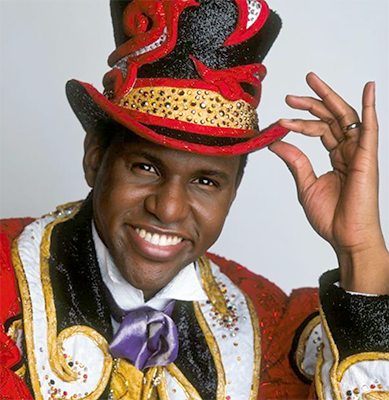 Johnathan Lee Iverson, 22 years old, became the youngest ringmaster of a major American circus. He was also the first African American ringmaster. He kept the job until the last day of the Ringling Circus. Johnathan Lee Iverson, 22 years old, became the youngest ringmaster of a major American circus. He was also the first African American ringmaster. He kept the job until the last day of the Ringling Circus.
|
||||||||||||||||
|
1999 |
Ringling human wonders |
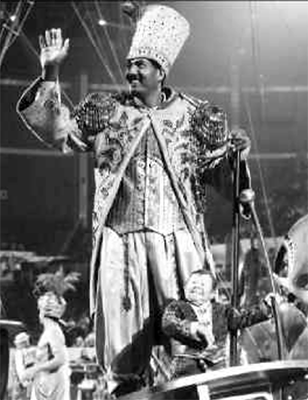 Michu was said to be the smallest man living (33 inches tall) and Khan the tallest (eight feet tall). But he wasn't the tallest in history: Jack Earle was six inches taller. Michu was said to be the smallest man living (33 inches tall) and Khan the tallest (eight feet tall). But he wasn't the tallest in history: Jack Earle was six inches taller. |
||||||||||||||||
|
||||||||||||||||||
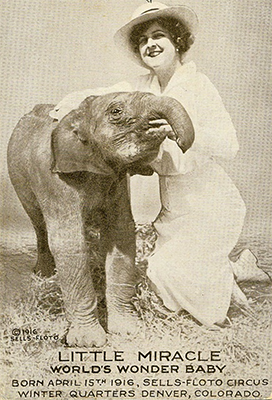 An elephant set a small circus apart from competitors:
An elephant set a small circus apart from competitors: 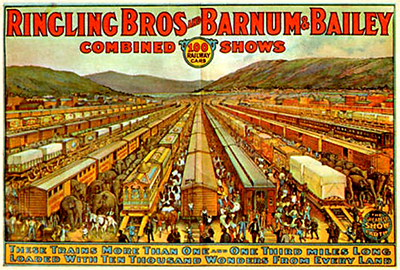
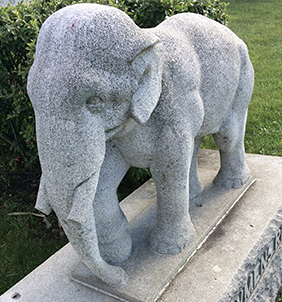 The circus missed only two performances. Rival circuses lent some of their acts.
The circus missed only two performances. Rival circuses lent some of their acts. 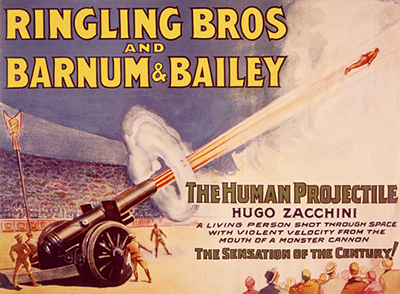 Hugo stood in a cylinder inside the "gun," the gun was elevated, the cylinder slid down, and a blast of compressed air (175 lbs. per square inch for a man) slammed the cylinder forward. A booming charge and smoke were added for effect.
Hugo stood in a cylinder inside the "gun," the gun was elevated, the cylinder slid down, and a blast of compressed air (175 lbs. per square inch for a man) slammed the cylinder forward. A booming charge and smoke were added for effect. 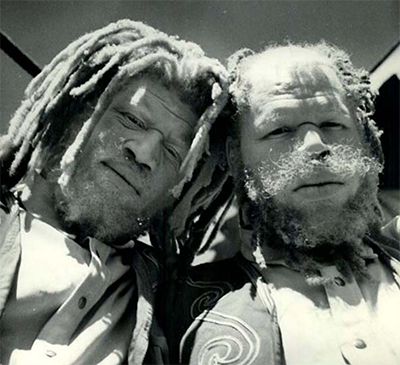 African albinos George and Willie Muse, who were billed as "Ambassadors from Mars, discovered near a crashed space ship in the Mojave Desert." First they were billed as "Sheep-Headed Cannibals from Ecuador," but being Martians was a better draw.
African albinos George and Willie Muse, who were billed as "Ambassadors from Mars, discovered near a crashed space ship in the Mojave Desert." First they were billed as "Sheep-Headed Cannibals from Ecuador," but being Martians was a better draw.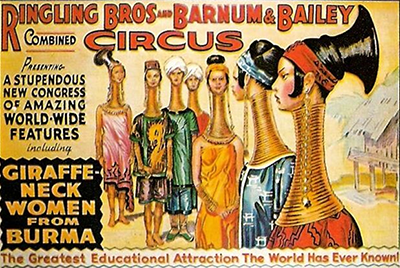 "Burmese Giraffe-Necked Women" permanently wore a stack of brass chokers that elongated their necks somewhat. They were advertised as "the greatest educational feature of all time!" People noticed the actual ladies weren't as long-necked as the poster showed, but the women were impressive enough. After two years they had earned the money they needed to return to Burma and build a mission.
"Burmese Giraffe-Necked Women" permanently wore a stack of brass chokers that elongated their necks somewhat. They were advertised as "the greatest educational feature of all time!" People noticed the actual ladies weren't as long-necked as the poster showed, but the women were impressive enough. After two years they had earned the money they needed to return to Burma and build a mission..jpg) She flipped herself over and over hanging from one wrist, doing a "full arm plunge." Her shoulder was dislocated as her body circled. The band played Flight of the Bumblebees and the audience ritualistically counted along, once up to 243 revolutions. Her hairpins would fall out, leaving her hair flowing "like a golden comet's tail."
She flipped herself over and over hanging from one wrist, doing a "full arm plunge." Her shoulder was dislocated as her body circled. The band played Flight of the Bumblebees and the audience ritualistically counted along, once up to 243 revolutions. Her hairpins would fall out, leaving her hair flowing "like a golden comet's tail." 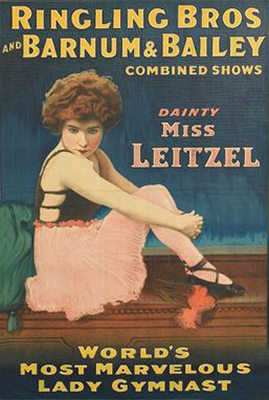 In 1931 Leizel's iron swivel ring apparatus broke in Copenhagen. She fell 40' onto her head and shoulders. She did not have a net, and did not survive long.
In 1931 Leizel's iron swivel ring apparatus broke in Copenhagen. She fell 40' onto her head and shoulders. She did not have a net, and did not survive long.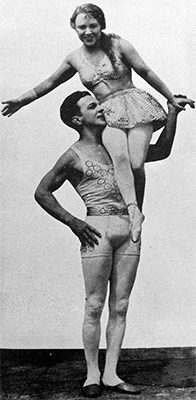 Leitzel married three times, the last time to the legendary, graceful Mexican
Leitzel married three times, the last time to the legendary, graceful Mexican 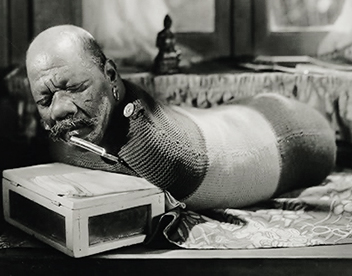
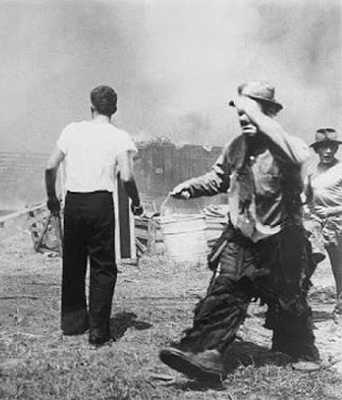 Kelly was performing at the Hartford circus when the big top caught
Kelly was performing at the Hartford circus when the big top caught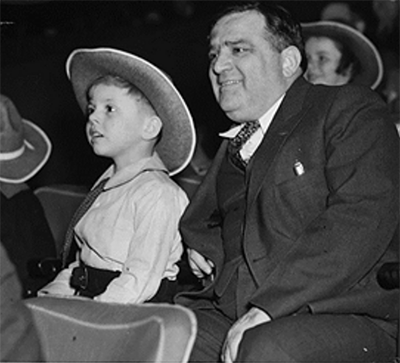 New York Mayor Fiorello La Guardia made a guest appearance in 1938. (To be honest, this picture of Fiorello with his grandson was taken at a different circus.)
New York Mayor Fiorello La Guardia made a guest appearance in 1938. (To be honest, this picture of Fiorello with his grandson was taken at a different circus.)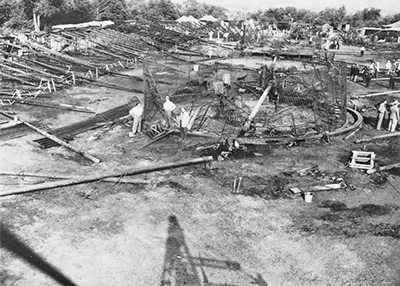 There were 168 known deaths, but the fire was so hot that it acted as a crematorium and there may have been more.
There were 168 known deaths, but the fire was so hot that it acted as a crematorium and there may have been more. 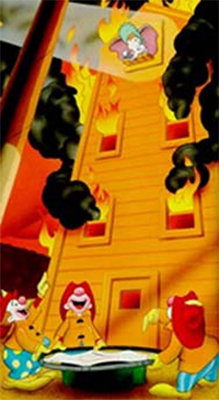 Ironically, the clowns in this show performed the classic
Ironically, the clowns in this show performed the classic 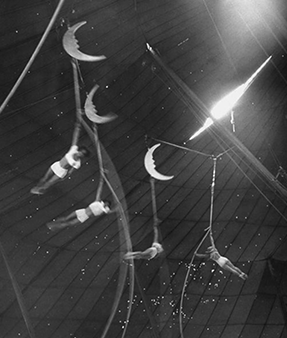
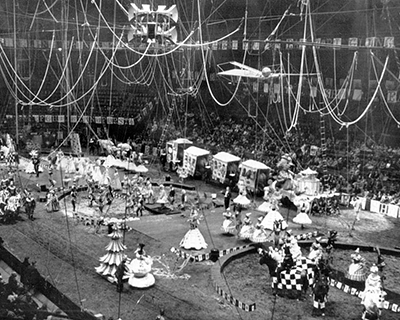 Putting on circuses in air-conditioned arenas saved a lot of money.
Putting on circuses in air-conditioned arenas saved a lot of money.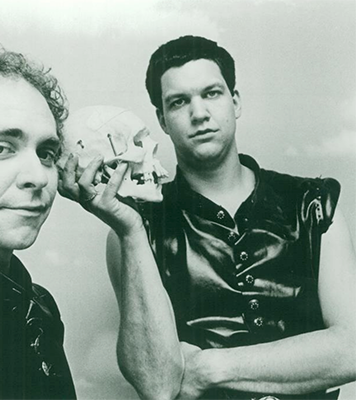 However, most graduates failed to define a character. They just wore colorful costumes and repeated old gags.
However, most graduates failed to define a character. They just wore colorful costumes and repeated old gags.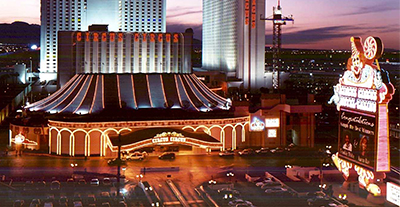
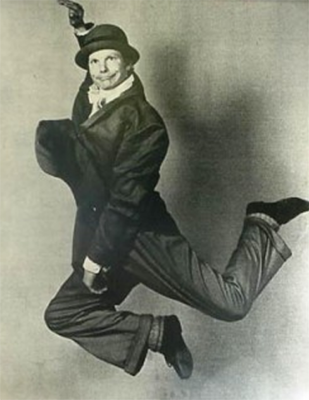 Bill Irwin joined: he was the first clown to win a MacArthur fellowship.
Bill Irwin joined: he was the first clown to win a MacArthur fellowship. 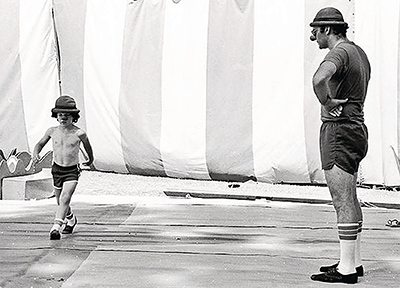 He spent hours locked onstage in a 3' x 2' trunk waiting to pop out with balloons. He actually ran away from the circus, which he explains in his autobiography Humor Abuse.
He spent hours locked onstage in a 3' x 2' trunk waiting to pop out with balloons. He actually ran away from the circus, which he explains in his autobiography Humor Abuse. 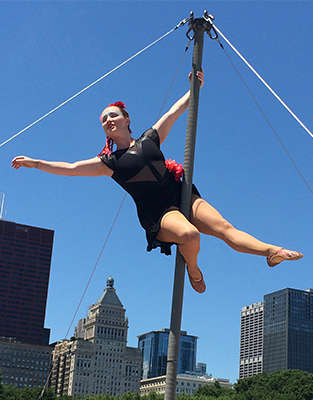 I decided to take a pass when they came to Chicago in the fall of 2017. I've been doing everything circus obsessively the past several months, but while I enjoyed Cirque du Soleil when I went a few years ago, they just don't say circus to me now.
I decided to take a pass when they came to Chicago in the fall of 2017. I've been doing everything circus obsessively the past several months, but while I enjoyed Cirque du Soleil when I went a few years ago, they just don't say circus to me now.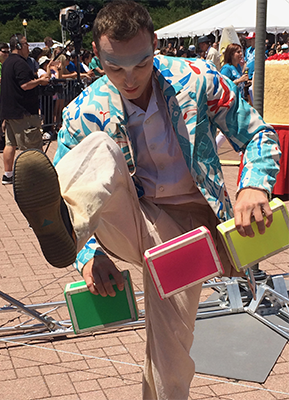 I did, however, go see the
I did, however, go see the